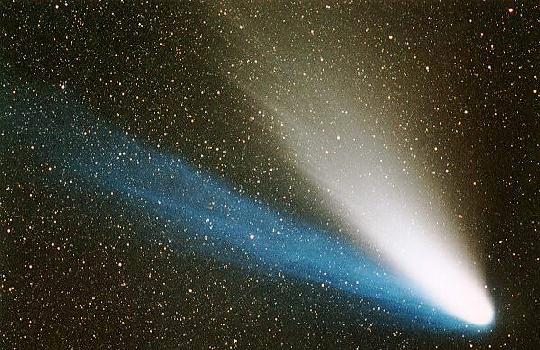Photo Credit: Huffington Post
Everything you didn’t know you wanted to know about Halley’s Comet. And more.
Contemplating your place in the universe can sometimes get a little…

…depressing. It is so inconceivably vast that all of the unknowns (dark matter???) start to stack until the entire premise of a universe at all is overwhelming. And while it certainly is an overwhelming field, astronomy (and all that it entails – astrobiology, astrophysics, space exploration, and more) is growing, and its scientists employ some of the most advanced human sciences to investigate some of the most obscure. Just this month, NASA test launched their newest spacecraft, Orion, on a two-orbit, four-hour trip. The successful run was one in a string of victories for this new technology built to take humans farther than they’ve ever been – beyond the moon.
As a little nod to all of the strides being made in the space community, here’s a brief history of an old classic: Halley’s Comet.
Surely you’ve heard of this famous comet, but you may not realize just how much is known about it – or how long it’s been paying visits to Earth. Its first recorded history dates back to 240 B.C. when Chinese astronomers noticed it passing through the sky. It was famously spotted in 1066 and treated as an omen for William the Conqueror before the Battle of Hastings. In 1705, Edmond Halley borrowed some equations from one Isaac Newton to track what he would soon realize were several orbits of a single comet. Mark Twain was born shortly after its appearance in 1835 and died the day following its next visit in 1910. Needless to say, it has witnessed a fair amount of history.

In 1910, when people panicked about its toxicity
As a short-period comet, Halley’s comes around once about every 75 years. That means that it is next expected in mid-2061 – 47 years from now. If that timeline seems grim, just think that in a few weeks, it will be only 46 years. Oh how the time flies!
And speaking of flying, there’s a reason why Halley’s Comet’s flight path is particularly vibrant. Like all comets, Halley’s is made of “dirty ice,” frozen water and other debris that actually make the surface of the comet pitch black. These compounds begin to boil and sublime as they approach the sun and, together with solid dust particles, create the atmosphere of the comet – its coma. As it continues to travel, solar winds push the particles away from the center of the comet, where they form into its long tail shape.

In 1986 when it was less vibrant than other visits
The reception of Halley’s has always been somewhat whimsical – especially since discovering that it comes around regularly. It is the event of a lifetime, unless you’re lucky enough to see it twice. In 1910, people worried that Halley’s tail was toxic and headed straight for earth; satirical advertisements recommended hiring a submarine boat, loading it with supplies, and waiting. “The deeper the spot the better,” and if after three days you’re alive, poke your head out and assess the damage. “If all the people in the world have perished under the deadly gas, you can claim the world for your own. If they are not dead – perhaps you can stand the laugh.”
But all those who stayed above water were rewarded with a sight that many before them had witnessed – so many, in fact, that the entire history of Halley’s Comet seems a bit surreal.






Leave A Comment
You must be logged in to post a comment.